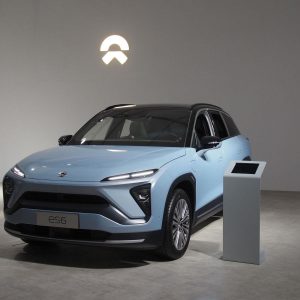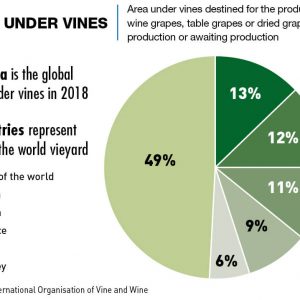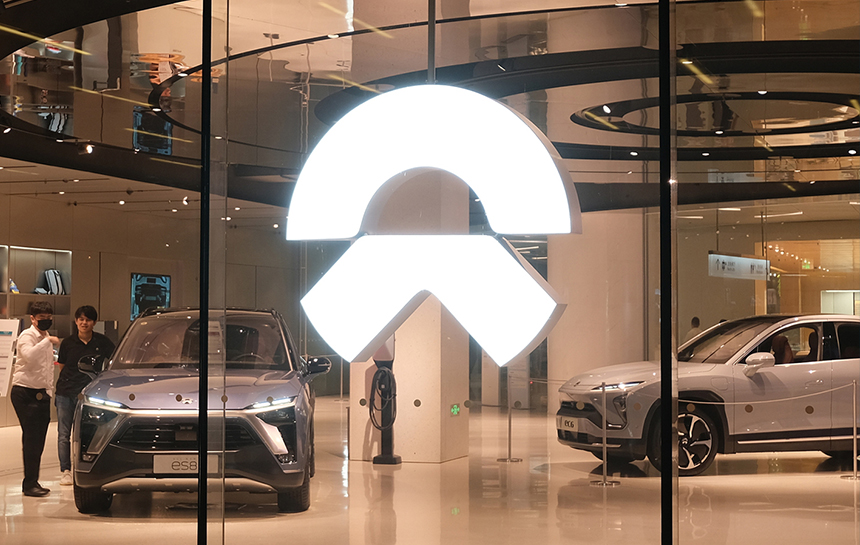State funding and innovative battery models are amongst the factors setting NIO apart from other Chinese EV startups

Ask anyone in the West to name some of the major players in the automobile industry and you will soon hear names like Volvo, Renault and Subaru, and it will be a long time before you get to the name NIO, even though, in market value terms, the young Chinese electric vehicle manufacturer outranks all of them.
Last year, NIO sold fewer than 50,000 of its high-end SUVs compared to Volvo’s 451,000 globally but both companies have a market capitalization of around $55 billion. You could be forgiven for thinking that the numbers don’t add up, but they reflect fast changing values in the auto industry. This year, NIO is on track to double its sales from the previous year and the company shows no signs of easing off the accelerator.
There is a growing sense in the market that the major auto companies are dinosaurs, ready to be overtaken by young, smaller players like NIO, which place as much value on data as they do the hardware of their cars. The data that is generated by the companies plays a key role in the massive valuations because companies like NIO and Tesla, for instance, have a relationship with car owners that allow them to collect large amounts of user information.
Launched in 2014 by auto industry veteran William Li, NIO has emerged as a leading player in China’s new electric vehicle (NEV) industry after shaking off a string of financial and operational setbacks in recent years. Now, with new lines of reliable financing and growing brand recognition, both at home and abroad, NIO is well positioned to become China’s EV king.
Getting into gear
In 2016, NIO secured the backing of Chinese tech giants Tencent and Baidu, and its first model—the sporty EP9 coupe—rolled off the Jianghuai Automotive Company’s production line. NIO, in line with other early-stage Chinese EV manufacturers, does not yet have a manufacturing plant of its own.
As of the second quarter of 2021, NIO has shipped a total of over 100,000 units, and its performance in 2020 was strong enough to rank it in the top five EV companies in China by sales volume, behind the Warren Buffet-backed BYD, China’s largest automobile manufacturer SAIC and of course, Tesla. But NIO’s revenue still lags far behind the big players, having taken in just RMB 16.25 billion ($2.5 billion) in 2020 compared with BYD’s RMB 153.5 billion ($23.78 billion).

Alongside the EP9 coupe, NIO currently has three mid-to-large luxury SUV models on the road: the ES8, ES6 and EC6, with others in the pipeline for the next few years. As the company itself proclaims, however, NIO is “much more than a car company,” and it has constructed a cohesive series of products around its core automobile offerings, including a clothing line and a wine brand. NIO’s mobile application, meanwhile, grants its 1.6 million users access to a wide range of car control services, tweaking the car’s air conditioning settings, for example. The app also contains a social media platform on which, in conjunction with the various products NIO offers, customers can build an almost exclusively NIO-based persona, thereby also building the strength of the NIO brand.
“NIO is well-situated among China’s premium NEV brands,” says one Chinese auto industry expert who declined to be named. “As a brand, they have managed to outdo both new energy and traditional car competitors by focusing on user experience and the software underpinning it.”
Despite a strong start in 2014, NIO’s rise began to stall after its deflating New York IPO in 2018. It raised only $1 billion instead of its targeted $1.8 billion, and investor enthusiasm waned due to concerns such as missed delivery deadlines and manufacturing defects.
“NIO faced the challenges of a young, single-product company that was burning through massive amounts of capital,” says Bill Russo, founder and CEO of Shanghai-based auto consultancy Automobility. “On top of fulfilling its pipeline, covering supply chain commitments and the massive infrastructure costs of building out its battery swapping network, NIO was also striving to create a digital platform for its users.”
The following 18 months saw NIO’s stock fluctuate sharply as uncertainty hovered around the company’s future. This changed in 2018, when the government of Hefei, an eastern Chinese city where NIO’s cars were manufactured in the early years, extended a RMB 7 billion lifeline to the ailing car firm. Since closing that deal, NIO’s market cap has grown 20-fold.
With its cashflow worries resolved, NIO’s ambitious plans, including expansion outside of China, starting with Europe, now look set to pay off in the long term. “From the beginning, NIO has leant into branding and customer engagement, which initially put them in dire straits,” according to Tu Le, founder of Sino Auto Insights. “Where other startups were not familiar with these elements, NIO understood the importance of trusting a brand, especially in the Chinese market today. The Hefei government has turned the heaviest weight around NIO’s neck into one of its key assets.”
Setting itself apart
Unlike Tesla and other regional competitors, NIO has committed itself to an industry business model known as “battery swapping.” Instead of constant recharging of a single battery, NIO lets users swap out depleted battery modules for fully-charged ones at service centers around the country. Though far from a new concept, battery swapping has yet to be successfully adopted by other NEV firms globally, largely due to standardization issues.
“Even the best batteries we have today are not nearly as dense (energy per unit volume) as gasoline, so suppliers tend to spread batteries throughout the body of the car to get enough range, making it tricky to swap out a single battery quickly,” says John Helveston, Assistant Professor in the School of Engineering and Applied Science at George Washington University.
Tesla, for example, introduced the idea of battery swapping in their 2013 Model S, but abandoned the tech citing reasons including cumbersome swapping stations and tepid consumer demand. But NIO drivers can roll in and out of one of the company’s 300 Power Swap stations within five minutes, the company boasts, and NIO hopes to have 4,000 stations worldwide by 2025.
Proving that this battery swap model can be scaled up throughout China will be a mammoth task, though for NIO users like Jing Tian, a marketing executive in Shanghai, the availability of Power Swap stations is yet to pose a problem. “I rarely travel too far outside the city,” she says. “But I don’t know what it would be like in one of the poorer, less populated provinces inland.”
Another novel business strategy that NIO is pursuing is the so-called “Battery as a Service,” or BaaS model, in which customers buy a NIO car without the battery, drastically lowering the upfront retail cost of the car while providing manufacturers with a new, consistent revenue stream.
“Up to one-third of the vehicle’s price can come from its battery,” says Halveston. “This battery will degrade over time, and when it’s time for replacement, it may make sense to just buy an entire new car.”
The price for the NIO ES6, for example, falls from around $52,000 to $42,000 when bought without the batteries. This is replaced by a recurring monthly cost of up to $140 for battery swaps and replacements.
Bumps in the Road
NIO may be on the way up, but this rising star in the NEV world continues to face challenges beyond its balance sheet, including concerns on global supply chains and the potential for international expansion.
NIO posted its first annual profit of RMB 1,873 million ($287.1 million) in 2020 but analysts are not yet ready to confidently predict that the company will continue to post profits, even in the short-term.
“The current emphasis worldwide on energy conservation and emissions reduction has generated a lot of positivity in the industry, helping to boost the market value of all NEV firms,” notes the Chinese analyst. “Despite coming out of the pandemic well, NIO and others like it still carry doubts about their short-term profitability.”
Given that NIO uses another company to manufacture their vehicles, it is more akin to a distributor at this point and there are hurdles to the company becoming its own primary manufacturer, the main issue being IP ownership. JAC, the company’s current production partner, owns the IP to the NIO ES8 manufacturing and CATL, the world’s largest battery-maker, owns the IP to the Powertrain technology used in NIO’s cars.
Political pressures
Since 2018, automobiles have been one of the key elements in the trade disputes between China and the US. Following several rounds of tariff packages, Beijing at one point levied a 5% tariff on auto parts, putting heavy pressure on local manufacturers.
Global supply chains were also severely disrupted in early 2020 thanks to the COVID-19 pandemic. “It’s important to note that supply chain shortages have been felt industry wide, not just by the EV segment or any one company,” says John Halveston. “But there’s a key difference between tariffs and shortages. The first can squeeze a firm’s bottom line, but a real shortage will squeeze output, as we saw during the pandemic.”
At the policy level, China’s NEV companies are also facing a sharp cutback of the substantial state subsidies that have fed the booming EV market over the last decade. The subsidies, already heavily reduced from previous years, will cease by the end of 2022, indicating that Beijing feels the sector no longer needs fiscal support.
“[The government is] confident to let the private sector take over,” says Tu Le of Sino Auto Insights. “The market has reached a point where many companies can go ahead and create new, cool, innovative products.”
But the cancellation of subsidies does not mean that Beijing has lost interest in EVs.
The last three Five-Year economic development plans set by the central government have featured goals for electric vehicle production, including the requirement that 20% of all vehicles sold in China by 2025 to be EVs. “That’s going to get smashed,” predicts Tu Le.
Sparking inspiration
Though NIO is still fighting hard for its slice of the Chinese market, its recent momentum points to exciting expansion ahead. NIO has announced plans to diversify from its high-end SUVs into the mass market with a new sister brand to flank its existing premium range, mirroring the dynamic between, for instance, Toyota and its premium brand Lexus. Beyond China’s borders, meanwhile, the NIO brand is using Europe as its first base for sales expansion.
NIO’s ES8 model went on sale in Norway in October with the ET7 to follow in 2022. At a press conference, founder William Li laid out his plans to construct an entire NIO ecosystem across Norway, complete with service centers, swapping stations and a series of NIO Spaces (exclusive communal areas for NIO users).
Norway appears to be a safe place for its first international foray, the Nordic nation has low tariffs and the highest per capita EV ownership in the world. But some analysts see the choice as being more symbolic than substantial.
“Going overseas tells the world you are internationally focused and growing,” says Tu Le. “Indeed, the EV penetration in Norway is high, but the market is still only around 250,000 units a year—about the same as Beijing’s Chaoyang District!”
Whatever the motivation, Norway is only the first stop in NIO’s international expansion. The trade tensions with the US have forced many ambitious Chinese companies to look to Europe as their first port of call for international growth. But unlike the mammoth American market, Europe is a mosaic of relatively rich economies, each with their own digital infrastructures, languages, and consumer tastes.
“NIO will meet a more competitive landscape in Europe with customers that have a legacy preference for European brands made in their home countries,” says Bill Russo. “The challenge for NIO will be to act quickly before the European brands get in the game.”
Future forward
If Beijing follows through on its commitment to reduce state subsidies for NEV companies, established players like NIO could enjoy the fruits of a reduced field of competitors as many smaller players leave the field. But EVs are increasingly favored by Chinese consumers for reasons including environmental friendliness.
“I can see myself getting very used to being an EV-driver,” says Jing Tian, when asked if she would consider a traditional gasoline model for her next car. “If my NIO has the same price, speed and ‘coolness’ as a BMW, why change?”
For now, NIO can feel comfortable that it has outgrown the financial struggles of its earlier years and the solid brand identity it has cultivated, with the sturdy backing of the Chinese government, gives it the freedom to innovate in a way that allows them to challenge Tesla and other industry giants.
“NIO is certainly what I would call a business model innovator,” says Bill Russo. “It is a ‘digital native’ company, having built a software-defined vehicle architecture with a user-centric business orientation. With that in place, they are well placed for a generational shift in buyer demographics towards smart, connected and sustainable technology.”




















